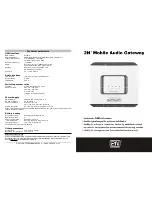
sample on
demand
Sample on demand allows a host system to send a Modbus command to any register and require the
inputs to immediately sample the sensor and report readings back to the host system. Sampling on
demand can be used between the normal periodic reporting.
To use the Sample on Demand feature requires using a host-controlled system capable of sending
Modbus commands to the master radio.
signal-to-noise
ratio (SNR)
The signal-to-noise ratio is the ratio of the signal to any background noise or noise generated by the
medium. In radio terms, it a ratio of the transmitted radio signal to the noise generated by any
electromagnetic equipment, in particular the radio receiver. The weaker the radio signal, the more of an
influence noise has on radio performance. Like gain, the signal-to-noise ratio is measured in decibels.
The equations for calculating SNR are:
SNR = 20 × log (Vs/Vn) where Vs is the signal voltage and Vn is the noise voltage;
SNR = 20 × log (As/An) where As is the signal amplitude and An is the noise amplitude; or
SNR = 10 × log (Ps/Pn) where Ps is the signal power and Pn is the noise power.
single-point
ground
All grounds within a system are made to a single ground to avoid creating ground loops.
site survey
Conducting a site survey, also known as a radio signal strength indication (RSSI), analyzes the radio
communications link between the Gateway (or master radio) and any Node (or slave radio) within the
network by analyzing the radio signal strength of received data packets and reporting the number of
missed packets that required a retry.
slave ID
The slave ID is an identifying number used for devices within a Modbus system. By default, Gateways
are set to Modbus Slave ID 1. When using more than one Modbus slave, assign each slave a unique ID
number.
sleep mode
During normal operation, the Sure Cross radio devices enter sleep mode after 15 minutes of operation.
The radio continues to function, but the LCD goes blank. To wake the device, press any button.
slow scan mode (All internal battery models)In slow scan mode, the radio wakes up every 15 minutes to search for its
parent radio. If a parent or master radio is not found, the radio goes back to sleep for another 15
minutes.
SMA connector An SMA connector (SubMiniature version A) is a 50 ohm impedance connector used for coaxial RF
connections and developed in the 1960s. An SMA connector is typically used between the radio and the
antenna.
spread
spectrum
Spread spectrum is a technique in which the transmitter sends (or spreads) a signal over a wide range of
frequencies. The receiver then concentrates the frequencies to recover the information. The Sure Cross
radio devices use a version of spread spectrum technology called Frequency Hop Spread Spectrum.
star networks
A star topology network is a point to multipoint network that places the network master radio in a center
or hub position. Slave radios only transmit messages to the master radio, not to each other. These
network layouts can be very flexible and typically operate relatively quickly. Slave radios acknowledge
receipt of messages transmitted from the master radio.
Sure Cross
®
Performance DX80 Wireless I/O Networks
www.bannerengineering.com - Tel: + 1 888 373 6767
65





































